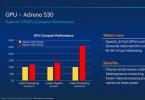Released in 2015, the flagship Qualcomm Snapdragon 810 chipset was not the most successful. It was prone to overheating, which is why it could not significantly outperform the mid-range Snapdragon 650 and 652 (which were shelved until the end of the year so as not to compete with the flagship). Therefore, fans of chips from this manufacturer were looking forward to the release of the new Snapdragon 820.
The characteristics of the Snapdragon 820 have changed a lot compared to its predecessor. Although the number of cores was halved, performance increased by the same 2 times (140 thousand versus 70, according to AnTuTu). To understand what the secret of such progress is, an analysis of the specifications of this SoC will help.
Process technology
The Snapdragon 820 is manufactured using a new 14nm FinFET process technology by Samsung. As of autumn 2016, these are the thinnest lithography standards used in mass production. This process technology, all other things being equal, provides a 30-50% reduction in power consumption (and heat dissipation), in comparison with 20 and 22 nm.
CPU
The Snapdragon 820 CPU consists of two clusters of 2 cores (big.LITTLE technology), with frequencies up to 2.15 and 1.6 GHz, respectively. It uses 64-bit processor cores on the Cryo microarchitecture, the company's own design. They are an alternative to the standard Cortex A72 cores developed by ARM Corporation.
Graphic arts
The Snapdragon 820 processor uses the latest generation Android 530 video core. It contains 256 universal computing units operating at a frequency of up to 624 MHz. Its performance reaches 500 GFLOPS. The GPU in Snapdragon 820 supports Vulcan, OpenGL 3.1, OpenCL 2.0 and DirectX 12.1 technologies.
The controller supports displays with a resolution of 4K (3840x2160), with a frame refresh rate of 60 FPS, or FullHD - 120 FPS. 10-bit signal coding is available, which is required to unlock the potential of IPS matrices. Supports displaying images on an external screen. 
Memory controller
SoC Snapdragon 820 is equipped with an integrated memory controller that supports LPDDR4 chips. The maximum bus width is 64 bits, its frequency is up to 1.86 GHz. The maximum interface bandwidth is 30 Gbps.
Connection
The Snapdragon 820 processor is equipped with a modem that supports LTE Cat.12 for reception and Cat.13 for transmission. Its speed is 600/150 Mbps. HSPA+ (3G), GSM, TD-SCDMA and CDMA networks are supported.
Wi-Fi is compatible with 802.11a, ac, b, g, n (2.4 and 5 GHz) and 802.11ad (WiGig) networks. Bluetooth complies with version 4.2. The IZat navigation box is designed to work with GPS, BeiDou and GLONASS satellites. 
Peripheral controllers
In addition to the Kryo processor, Snapdragon 820 incorporates a Hexagon 620 DSP (digital signal processor), operating at up to 1 GHz. It takes the load off the main CPU cores in low-level tasks.
The Snapdragon's 14-bit camera controller is capable of processing up to 1.5 gigapixels per second. The chip is able to provide parallel operation of a pair of matrices with resolutions up to 25 MP, or one at 28 MP. Also among its features is support for recording video in 4K at up to 60 FPS.
Features Snapdragon 820
The characteristics of the Snapdragon 820 look impressive, but let's try to figure out what opportunities it offers in practice. First of all, the computing power of the processor and chipset graphics is impressive. Qualcomm did a great job and were able to achieve performance comparable to the top PCs of 2007 (Intel Core 2 Quad + GeForce 8800GTX). Almost a year later, only Apple could repeat the success with its A10 Fusion. Such power is enough for any 3D game with realistic graphics to work without brakes for at least another 3 years.
The combination of powerful screen and camera controllers makes smartphones based on the Snapdragon 820 processor well suited for virtual and augmented reality. Simultaneous processing of the data stream from the camera and displaying the image on the screen allows you to create objects in AR and VR environments in real time.
The presence of a signal coprocessor and the integration of all controllers and network modules expands the possibilities for energy saving management. Thanks to this, the processor remains a third cooler than its predecessor, even under maximum load.

Popular smartphones based on Snapdragon 820
Despite the high (about $ 70) starting price, smartphone manufacturers were actively interested in the SoC Snapdragon 820. In the first months of 2016, it was installed in several models that firmly settled in the leaders of the AnTuTu benchmark.
Samsung Galaxy S7
One of the first smartphones based on the Snapdragon 820 processor was the Samsung Galaxy S7/S7 Edge in modifications for the US and China. The rejection of its own Exynos 8890 chip is due to the fact that Qualcomm's integrated modem is adapted to the CDMA and TD-SCDMA networks popular in these countries. The smartphone is equipped with one of the best cameras in the mobile world.
Xiaomi Mi5
In parallel with Samsung, Xiaomi released its flagship on the Snapdragon 820 chip. The device was distinguished by the fact that at a price of $ 300, for some time it occupied the first line in the official AnTuTu rating. The device is equipped with a FullHD screen, a good 16 MP camera, as well as a stylish glass and ceramic body.
One Plus 3
Another "flagship killer" is distinguished by the presence of as much as 6 GB of RAM. Thanks to the combination of the Snapdragon 820 processor and this amount of RAM, it has been leading the official AnTuTu TOP for a month now.
HTC 10
Like most flagships in 2016, it received a Snapdragon 820 processor and HTC 10. It features an excellent QHD screen, stereo sound, a 12 MP ultra-pixel camera and a metal case.
Sony Xperia X Performance
Sony's new flagship is also not without a top-end Qualcomm processor. The manufacturer decided to stop experimenting with 4K for the time being, installing a regular FullHD matrix, but other characteristics (camera, memory, design) remained at their best.
You will also like:

 The best compact smartphones of 2018
The best compact smartphones of 2018
Qualcomm at a press conference in New York officially introduced the "processor of the future" Snapdragon 820, which will be installed in flagship devices from next year. The chipmaker started to stir up interest in the "top" mobile platform a few months ago, and today he held the first practical demonstration of the novelty.
Based on 14nm FinFET (3D Structure Transistor) process technology, the Snapdragon 820 is powered by 64-bit Kyro cores clocked at up to 2.2GHz. They are complemented by the Adreno 530 graphics controller with support for OpenGL ES 3.1 + AEP (Android Extension Pack), Renderscript, OpenCL 2.0 and Vulcan API, Spectra IPS processor, Hexagon 680 DSP digital signal processor and X12 LTE modem. Vesti.Hi-tech learned what new this chip will bring to smartphones and tablets in 2016.
High speed computing
First, the Snapdragon 820 is twice as fast as its predecessor, the Snapdragon 810. The quad-core heterogeneous computing mode (HMP) chipset configuration includes two high-performance cores clocked at 2.2GHz to solve demanding tasks, and two more - low-power (1.6-1.7 GHz) for less demanding processes.
The architecture of both clusters, Qualcomm said, is the same, they differ only in the cache configuration (how, it is not specified). As needed, the chip offloads some types of computing to other components, such as the powerful Adreno 530 graphics accelerator, the Hexagon 680 digital signal processor, and the Spectra ISP image processing chip. The controller delivers up to 40% more graphics performance than the Adreno 430 while being just as power efficient. The graphics are designed for "next-generation virtual reality, computer vision, augmented reality applications," the company claims.
Battery saving
The Snapdragon 820 is not only twice as fast, but also more energy efficient than the 810. The company says that the new product consumes less power, including due to the “volumetric” FinFET (3D structure transistors) process technology and a modified 64-bit architecture. However, this does not mean that the increased frugality of the latest chip will double the battery life of a smartphone or tablet. Most likely, against the background of increased performance, the 820th will consume no more battery power than the Snapdragon 810.
Super accurate fingerprint sensor
One of the most impressive features of the Snapdragon 820 is its Sense ID 3D fingerprint recognition technology. Unlike the capacitive sensors ubiquitous in Android devices, Qualcomm's system scans the papillary pattern with ultrasonic waves, allowing it to penetrate plastic, glass, and even metal alloys. In addition, Sense ID will not hurt to "recognize" the owner if his finger is wet or dirty.
Improved photo and video quality in low light
The Snapdragon 820's Spectra imaging ISP chip processes photos and videos taken with the device's camera faster (support for new 1µm pixel sensors is included), provides a wider range of colors, and supports a hybrid focus system that allows faster focus on specific areas of the frame. The presentation in New York showed how Spectra ISP improves the quality of photos and videos with underexposed areas by brightening the picture, emphasizing the visibility of shadows and eliminating digital noise.
Stable LTE connection
The latest Qualcomm processor supports TruSugnal technology, which detects the source of interference (such as the user's palm) and optimizes antenna reception accordingly. You can already see this feature in action on the LG V10 smartphone. Calls over Wi-Fi have been improved: if the connection quality is poor, the Snapdragon 820 will be able to independently switch between LTE and a wireless network, when necessary.
In addition, the Qualcomm chip works in high-speed LTE networks (up to 600 Mbps) and supports the 802.11ad Wi-Fi standard (also known as WiGig). The 802.11ad specification is more like "USB without wires": this technology operates at a very high center frequency (60 GHz), which does not allow it to pass a signal through walls.
So, with the help of WiGig it will be possible to connect devices that are quite close to each other (within a few meters). Despite the "myopia", 802.11ad provides speeds up to 7 gigabits per second, that is, almost 50 times faster than 802.11n. The scope of the standard is the connection of monitors, external hard drives and other peripherals, as well as the transmission of large amounts of data over a wireless network, such as uncompressed HD video.
Built-in Cyber Threat Protection
The Snapdragon 820 features Smart Protect hardware technology powered by the Zeroth cognitive computing platform, which provides real-time protection against malware. The self-learning system analyzes and classifies malware on the fly, and ensures the security of personal data by preventing viruses from infecting the device. Smart Protect, they say in Qualcomm, does not affect the performance and battery life of the gadget.
The appearance of the first devices with Snapdragon 820 is expected in the second half of 2016. The novelty can also be seen in "smart" cars.
Not so long ago, we came out, part of which was devoted to the scheme of operation of some models of single-chip systems. The results of testing SoC Snapdragon 808 turned out to be interesting, which did not show its best side, but later even less attractive chips came out in the form of Snapdragon 615 and 430, which I didn’t even want to talk about.
advertising
A little later, a short article was published on Personal Pages about the specifics of the work of the ten-core MediaTek Helio X20, which also did not meet the expectations of users in many areas.At that time, we met with the problems of the scheduler, which was so eager to maintain acceptable chip power consumption that, apart from benchmarks, it did not really use the cluster of productive cores. This was to be expected, since letting all ten cores work at the same time, they will instantly drain the battery and / or overheat. 
As a result, when choosing a smartphone from a technical point of view, a new variable appears - the scheduler. Each manufacturer of mobile solutions independently designs it and sets the modes of operation, which we will see today. Therefore, not all yogurt chips are equally useful, and you can expect different results in practice from the same SoC. In benchmarks, they will usually be similar.
Today we have a Qualcomm Snapdragon 820 single-chip system, which is interesting primarily because it has four cores with a classic layout that operate at different maximum frequencies. Yes, the review was a little delayed, but the “better late than never” rule applies here, because Snapdragon 821 is just an overclocked version of the same chip, and there are still a few months before the release of a fundamentally new SoC.
advertising
Specifications
| Parameter / Model | Snapdragon 805 | ||
| Number of cores, pcs. | 4 | 4 + 4 | 4 |
| Architecture | kryo | Cortex-A57+A53 | Krait 450 |
| CPU frequency | 2 x 2.15 GHz + 2 x 1.6 GHz | 4 x 2.0 GHz + 4 x 1.44 GHz | 4 x 2.7 GHz |
| The scheme of operation of the CPU cores | – | big.LITTLE (GTS) | – |
| Process technology, nm | 14, FinFET LPP | 20 HPm | 28 HPm |
| GPU | Adreno 530 | Adreno 430 | Adreno 420 |
| GPU operating frequency, MHz | 624 | 650 | 600 |
| RAM | LPDDR4 | LPDDR4 | LPDDR3 |
| Number of RAM channels | 4 x 16 (64bit) | 2 (32bit) | 2 (64bit) |
| RAM frequency, MHz | 1866 | 1600 | 800 |
| Theoretical memory bandwidth, GB/s | 29.8 | 25.6 | 25.6 |
If you compare the review hero with its predecessors, you can see a serious difference between all generations of SoC. In fact, we see the return of the concept of the usual layout of cores after a not very successful attempt to play on the big.LITTLE scheme, which is still so popular among competitors.
And this is good news, since it almost does not allow the scheduler to do stupid things and forcefully transfer, for example, one intensive stream of computing in the browser to a “weak” Cortex-A53 cluster running at a low frequency. This explains the marginal perceived difference in the speed of everyday applications when switching from Snapdragon 805/801 to 810/808 chips, despite the clear advantage of the latter in benchmarks.

With the release of the Snapdragon 820, everything is back to normal. We get four “thick” cores that provide high performance even at low frequencies, and working with the device on the new hardware platform is really very different from the old generations, this is clearly visible even with the naked eye.
Theory
Scalability
So, we have a quad-core CPU. Let's try to "go head-on" and evaluate scalability in the most primitive way - using the GeekBench benchmark. Why exactly him? We know that his Single Core results scale nicely with the number of cores used, almost proportionally if cooling allows:

And in general, this is quite an adequate benchmark, which, with the advent of the fourth version, makes modern SoCs mercilessly throttling, but that's not about that now. If we collect the results of testing smartphones on Snapdragon 820, conducted in our laboratory, we get the following picture:

And since in this case we are not interested in throttling, the third version of the program is appropriate here. As you can see, the scalability is clearly not 4x or even 3x. But this chip cannot be recognized as a dual-core one either. It seems that this is how it should be, when four cores are involved at once, they will at best operate at a frequency of 1.6 GHz, that is, at the maximum frequency of a “slow” pair of cores. Or not?
Qualcomm has two powerful and at the same time successful processors in its arsenal Snapdragon 820 and Snapdragon 650, we offer you a comparison of these two mobile chips and understand what is the difference between them.
Snapdragon 820 processor

This is by far the most powerful and flagship mobile processor from Qualcomm, the company decided to follow the right path of optimizing the SoC, and not in a dead end - increasing the number of cores.
The 64-bit Snapdragon 820 has a total of 4 Kryo cores at 2.2GHz and an Adreno 530 graphics system that is 40% faster than the previous generation Adreno 430. In addition, the processor has a built-in X12 LTE modem with a maximum download speed of 600 Mbps. It supports cameras up to 25 megapixels, and can record and play 4K video without any problems. The Snapdragon 820 is also designed to be compatible with USB 2.0 and USB 3.0 and with UFS 2.0 storage.
Snapdragon 650 processor

The Snapdragon 650 is a 64-bit 6-core processor from Qualcomm, which is used in mid-range and high-end smartphones. In the line of chipsets from Qualcomm, it is second only to the Snapdragon 820 in terms of power.
This processor is built on a 28 nm process and in its architecture contains 2 ARM Cortex A72 cores and 4 ARM Cortex A53 cores. The maximum clock frequency of the chip is 1.8 GHz per core. The Snapdragon 650 is equipped with an X8 LTE modem with a download speed of 300 Mbps. This is a fairly powerful and modern processor with USB 2.0 support and dual-channel LPDDR3 933 MHz memory.
Compare Snapdragon 820 vs Snapdragon 650
| Snapdragon 820 | Snapdragon 650 | |
| Number of Cores | 4 Kryo cores 64-bit | 6 cores: 2xARM Cortex A72 and 4xARM Cortex A53 |
| Clock frequency | 2.2 GHz | 1.8 GHz |
| Graphics core | Adreno 530 GPU | Adreno 510 GPU |
| fast charging | Qualcomm Quick Charge 3.0 | Qualcomm Quick Charge 3.0/2.0 |
| LTE modem | X12 LTE 600Mbps | X8 LTE 300Mbps |
| Camera support | up to 25 MP | up to 21 MP |
| Display support | 4K Ultra HD | Quad HD (2560×1600) |
| Bluetooth | Bluetooth 4.1 | Bluetooth 4.1 |
| WiFi | WiFi 802.11ac | WiFi 802.11ac |
| Those. process (nm) | 14 nm | 28 nm |
| USB | USB3.0/2.0 | USB 2.0 |
| storage |
UFS 2.0, eMMC 5.1 |
UFS 2.0 |
Qualcomm has moved on from a bad experience with the Snapdragon 810. That 20nm chip was not optimized for heat dissipation, the pursuit of the number of cores ended badly. The new Snapdragon 820 has four cores, not eight, but made using the most modern 14 nm technology (similar to the top Samsung processor in the Galaxy S6, Note 5 models). Apple generally has 2 cores, and no one complained about performance. Let's see what happens with Qualcomm.
Heat dissipation has become almost the main problem for Qualcomm, so everything was done in the new 820 model to avoid overheating. We are waiting for real devices to test it!
So far, a little theory: the new Adreno 530 GPU is 40% more productive, and just as economical, so that in the most important scenarios (games, shooting and video playback) we will get a profit. The chip architecture has a separate DSP (signal processor) Hexagon 680 and Snapdragon Sensor Core, which are responsible for tasks that require low performance, but constant activity (calls, notifications, GPS, etc.), so that the main processor is not always active (again , like the Apple A9, for example).
Technologies that can be forgotten
Every time Qualcomm introduces interesting technologies that go into the platform. These are augmented reality technologies, and glasses-free 3D, and lossless digital zoom. Here's what the company did when announcing the Snapdragon 810.
This year, when the Snapdragon 820 was announced, special attention was paid to several points:
1. Fast charging Quick Charge 3.0. Now it will work in devices with metal cases, and the charging pads themselves can be placed under the surface (furniture, for example). This is possible thanks to the induction principle of operation, which does not require direct contact of two surfaces. The 2750 mAh battery charges in 35 minutes from 0 to 80%! How many hours do you charge your iPhone 6 Plus?
2. Taking photos and videos in the dark. In the near future we will show a demo: on one device the function is enabled, on the second it is disabled. It's not recording, it's real-time shooting, and the smartphone/tablet adjusts to the lighting conditions instantly. For now, a photo:
3. LTE X12 and Wi-Fi Calling. LTE cat.12 - for the first time in the world, the download speed will be up to 600 Mbps (now in LTE Cat.9 - up to 300 Mbps). Movies can be downloaded twice as fast.
4. Graphics system in the gameplay adjusts to the lighting conditions. This is essentially real-time HDR, which was previously not enough processor power. If you play in the dark - please, the picture will be highlighted not just in its entirety, but only in areas located in the shade.
An error occurred during the download.
But smartphone manufacturers are not required to use them. This is a matter of desire and financial capabilities. If, say, Samsung wants to spend money on introducing technology - and voila, in some Galaxy S7 we will get such shooting in the dark, charging in 35 minutes, LTE Cat 12 and improved antenna performance, which guarantees an excellent signal even in a metal case.
But this is all possible in an ideal world. The implementation of additional technologies is time and cost. The flagship will be golden not only in terms of body color.
So at best, you should hope for one, maximum two technologies of the new platform. So far, of Qualcomm technologies, wireless charging has taken root well, fast charging is what consumers needed most according to smartphone manufacturers. So Quick Charge 3.0 will definitely appear in future flagships. Charging your smartphone in half an hour is cool.
Will it take off?
Our opinion is yes. There are many facts: after the failure with the 810th, the company does not have the right to step on the same rake. Instead of hot 8 Cortex cores, custom Kryo cores were used on a 14nm process technology. Custom means in-house development, not ARM development in the case of Cortex. So does Apple, for example.
The new graphics chip performed well in the demo. Fast charging just got faster and now charges a standard battery in just 35 minutes. If statements about a strong reduction in energy consumption are confirmed, we will get long-lasting and fast-charging flagship gadgets. And finally, Samsung undertook to produce all this. They definitely have experience with the 14-nanometer process technology: the Galaxy S6 and Note 5 are productive and long-lasting. No wonder the Koreans are planning to use the 820th in the Galaxy S7!
Tell your friends about the new superprocessor by clicking on any of the social media buttons below ↓↓↓



